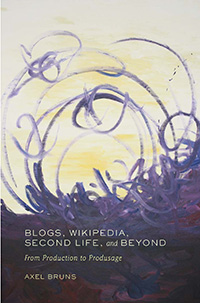You are here
The Brownian Motion of Collective Intelligence?
Some of my colleagues at QUT are involved in a new project they describe as 'cultural science' - a combination of cultural studies, economics, and other scientific methodologies, in order to arrive at a more rigorous and testable framework for the study of cultural activity. I've posted some more about this over at snurb.info, and there's now a Cultural Science Website which has more information. I've cross-posted the following blog post on the Cultural Science blog.
I was lucky enough to attend part of the Brisbane meeting which officially kickstarted the project of cultural science, and I've been trying to trace the connections from here to my own work since then. I know little about economics, but for a couple of years before switching to media studies, I trained as a physicist, and a recent blog post by Yihong Ding has made me believe that some fields of physics, too, have valuable models to contribute to cultural science. In particular, it might be worth examining the way that particle and fluid dynamics describes the transition from random interaction at a micro level to orderly and predictable behaviour at a macro level.
But first, some background: the focus of my research is on user-led collaborative content creation, or what I've come to call produsage. One of the fundamental challenges in this field is to understand the processes of collective intelligence that arise in large-scale collaborative environments, and the conditions under which they flourish best. What makes Wikipedia work, for example? What would make it work better? What enables The Wisdom of Crowds to emerge, as James Surowiecki describes it?
We're starting to see a few interesting responses to such questions emerge now. In refuting former Britannica editor Robert McHenry's attack on the Wikipedia model of open editing, for example, Aaron Krowne makes the deceptively simple observation that for Wikipedia's average content quality to improve over time, p > an must be true, with p representing the number of constructive and n the number of disruptive edits. (We could simplify this to p = an without losing any meaning.)
In this, a is a factor above one - and most likely well above one: for p = 2n, for example, every second constructive edit would simply do the work of undoing a previous disruptive edit; for p = 10n, only 10% of all constructive edits fix previous disruptions, and the other 90% can get on with the task at hand.
Of course, such generic formulas only describe average content quality; for a more sophisticated analysis we'd have to distinguish between major and minor edits, as well as distinguish between aggregate edit counts across the entire project and the number of constructive or disruptive edits made for each topical field in the encyclopaedia, or even for each page.
As we dig down from the macro to the micro level of distributed collaboration, we come to grapple with the question of how and where individual contribution translates and accumulates into collective action, even collective intelligence. We come, in particular, to the question of why "the collective decisions made by independent participants with highly diverse disciplinary areas [are] generally at least not worse than the collective decisions ... by participants who are professional experts in the particular disciplinary area of the question", as Yihong Ding writes.
Ding draws on the principles of Brownian Motion to explain the observation that under some circumstances, non-expert collectives may even be more effective at finding solutions than groups of experts. The reason for this counterintuitive phenomenon has everything do with diversity: experts often think at least roughly alike, and will pursue mainly those directions which their established knowledge leads them to believe will be most successful; non-experts, on the other hand, act more randomly, allowing for a more probabilistic approach that - while often reaching similar conclusions to the experts - also allows for unexpected discoveries in a very different direction. In fluid dynamics and collective intelligence processes alike, Ding suggests, Brownian Motion provides that diversity.
Additionally, especially for non-experts, it may turn out to be beneficial if the community isn't too tight-knit: closeness may stifle the contribution of dissenting views for fear of their being seen as disruptive. The analogy for this from physics is heat, I suppose: close communities are cooler liquids in which individual particles are less mobile; more open communities are hotter, and individual movement is more random and energetic - for better or for worse.
Which raises several questions that cultural science, if it builds on applicable mathematical models for explaining interactive dynamics as they exist in disciplines from physics to economics, may be able to address: what level of 'heat' would be most conducive to the operation of collective intelligence in the context of any one community? What ratio of expert and non-expert contribution, and what process of mixing between the two, incubates innovative ideas most reliably, most quickly, and/or while exploring an optimal diversity of options?
Such questions are being explored in practice all the time, through trial-and-error processes that would make even the old warhorses of experimental physics blush. Wikipedia dissident Larry Sanger's Citizendium enyclopaedia, for example, has dialled down the heat and switched to a much more expert-rich mixture, and as a result, the rate of content improvement seems slower than it is over at Wikipedia - even if we adjust for the much larger contributor base that Wikipedia is able to draw from. Citizen journalism pioneer Indymedia, on the other hand, operates on high heat all the time (by allowing anyone to post to its sites, without editorial oversight and indeed without a need to engage with the community at all) - and as a result, quite a few sites, including Brisbane Indymedia, crashed and burned.
To describe these developments in the language of physics is more than just a matter of using physical phenomena as metaphors (I hope) - it seems to me that there is an opportunity to develop testable, observable mathematical models for collective intelligence dynamics by building on dynamics models in physics (indeed, I wonder what extent of overlap there is already between economic models for market dynamics, and their counterparts in physics). Such models could influence the design and development of current and future produsage projects, and contribute markedly to a more effective harnessing of the power of collective intelligence.
To borrow from another scientific discipline not (yet?) represented in the cultural science project: astronomers speak of a 'habitable zone' around a sun - a range within which there's just enough energy coming in to keep water liquid and the atmosphere gaseous, neither too cold nor too hot (the zone is therefore also nicknamed the 'Goldilocks zone'), which enables the evolution of life. Our Earth is just far enough away from the sun to be in that zone; Venus and Mars probably aren't, and Mercury or the outer gas giants certainly aren't. In a similar way, by accident or by design, Linux, Slashdot, Wikipedia, and the other success stories of produsage have managed to find their own habitable zones, and life there is flourishing; can we use cultural science to establish a clearer picture of exactly is required to sustain these lifeforms?
- Snurb's blog
- Log in to post comments
- 13829 reads
 Printer-friendly version
Printer-friendly version



Comments
glad to watch you opinion
Glad that you like the post I have made.
The Web is currently experiencing a transition of the structure of information organization. From one side, there is more and more user-generated content. On the other side, many "new" user-generated content is not really new. By contrast, it only remixes the existing content in various new ways. This trend, as in my word, is a transition from the previous publisher-oriented Web to the new viewer-oriented Web. From the rise of Web 2.0, this trend has become unstoppable and I predict that information reorganization would be the key issue of the next-generation Web, or the generally called Web 3.0.
An important research issue from the aspect of social science might be that how we can prompt this transition in a healthy way. In order to ensure the quality of collective intelligence, we need to know all the factors that may affect the quality. Brownian Motion is an interesting natural phenomenon that may help us in this study.
I like the word "produsage" you have coined. I will try to find a copy of your book to read. It has an attractive title. ;-)
Yihong